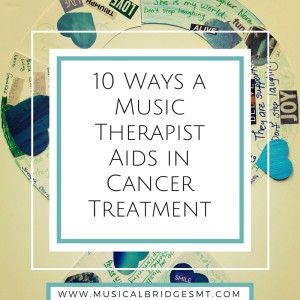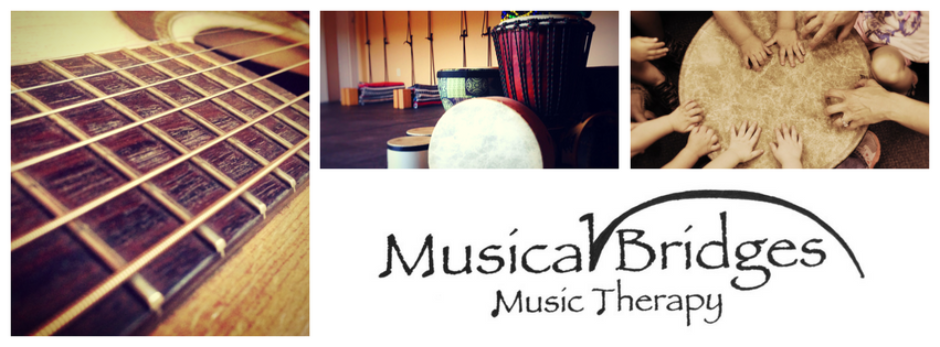 Music therapists can be very useful in cancer treatment and are beginning to be seen more and more in the hospital setting. There are a variety of interventions and treatment strategies the music therapist is trained to implement as well as a variety of settings the music therapist can be found. These settings include inpatient oncology departments, chemotherapy and radiation therapy, palliative care (hospices) and support groups. If the subject of music therapy and cancer treatment is new to you, you may be asking yourself “what does the music therapist do to help in cancer treatment?”
Music therapists can be very useful in cancer treatment and are beginning to be seen more and more in the hospital setting. There are a variety of interventions and treatment strategies the music therapist is trained to implement as well as a variety of settings the music therapist can be found. These settings include inpatient oncology departments, chemotherapy and radiation therapy, palliative care (hospices) and support groups. If the subject of music therapy and cancer treatment is new to you, you may be asking yourself “what does the music therapist do to help in cancer treatment?”
The music therapist can aid in…
1. Pain Management– Through carefully selected and designed interventions the music therapist works with patients to alleviate pain and pain perception. Treatment is non-invasive, meaning it is safe to administer and may reduce the amount of prescription pain medication administered to the patient. Research supports the effectiveness of music therapy intervention in the alleviation of pain in hospice patients with a cancer diagnosis as well as other medical settings.
-Colwell, C. (1997). Music as distraction and relaxation to reduce chronic pain and narcotic ingestion: A case study. Music Therapy Perspectives, 15, 24-31.
-Horne-Thompson, A. & Grocke, D. (2008). The effect of music therapy on anxiety in patients who are terminally ill. J Palliat Med. 11(4):582-90.
-Longfield, V. (1995). The effects of music therapy on pain and mood in hospice patients. Unpublished master’s thesis: Saint Louis University, USA.
-Siedliecki, S.L. & Good, M. (2006). Effect of music on power, pain, depression and disability. J Adv Nurs. 54(5):553-62.
2. Relaxation- Relaxation can be difficult for patients to achieve, especially those who are just beginning their cancer treatment, or those who are dealing with the side effects from treatment. Music therapists are trained to facilitate various musical relaxation techniques with patients which can aid in relaxation and often times help with sleep, reducing the need for additional medication. A more relaxed body results in less muscle tension, improved respiration, lower blood pressure, improved cardiac output and reduced heart rate.
3. Reducing Stress/Anxiety- Anxiety naturally goes along with learning of a cancer diagnosis, receiving treatment, preparing for surgery or perhaps preparing for end of life. Unfortunately, anxiety also can make symptoms worse and recovery more difficult by the stress it puts on the mind and body. Music therapists can aid in helping patients release stress/anxiety through instrument playing, singing, songwriting and processing feelings. In addition, simply listening to live music provided by a music therapist has been shown to decrease anxiety of patients while undergoing chemotherapy treatment and those in hospice care.
-Harper, E.I. (2001). Reducing Treatment-Related Anxiety in Cancer Patients: Comparison of Psychological Interventions. Dissertation: Southern Methodist University, USA.
-Horne-Thompson, A. & Grocke, D. (2008). The effect of music therapy on anxiety in patients who are terminally ill. J Palliat Med. 11(4):582-90.
-Ferrer, A. (2007). The effect of live music on decreasing anxiety of patients undergoing chemotherapy treatment. Journal of Music Therapy, 44 (3), 242-255.
4. Uplifting Mood– Music, when used appropriately, has an amazing ability to uplift mood. However, one must be careful in believing that just by playing a happy tune this will in turn uplift those who are sad or agitated. Music is a powerful medium that can have just as severe negative results as positive ones. There are a lot of factors that go into uplifting mood with music and the music therapist is trained in recognizing these factors and choosing the correct music and intervention to alleviate depression and improve affect.
-Longfield, V. (1995). The effects of music therapy on pain and mood in hospice patients. Unpublished master’s thesis: Saint Louis University, USA.
– Walden, E. (2001). The effects of group music therapy on mood states and cohesiveness in adult oncology patients. Journal of Music Therapy, 38 (3), 212-238.
5. Reducing Nausea– Research has shown that listening to music reduces nausea in patients receiving chemotherapy. In addition, singing may be a powerful intervention in relieving feelings of nausea due to the increased amount of oxygen taken in while singing compared to when speaking. The music therapist can also aid in reducing medication for the patient as with pain management listed previously.
-Standley, J.M. (1992). Clinical applications of music and chemotherapy: The effects on nausea and emesis. Music Therapy Perspectives, 10, 27-35.
6. Socialization– Often times patients feel alone in their treatment. Whether they have strained relationships with their families, have no surrounding family in the area, or are introverts who have a small support system, these patients often times isolate themselves and do not communicate feelings. Music’s amazing ability to access emotions and create a safe environment can be a wonderful treatment for these patients whether in individual or group settings. The music therapist uses music to facilitate socialization, self expression and may often times be the friendly support the person has been looking for. People tend to talk openly and willingly about their music preferences and experiences which is a great way to open the door for communication which can lead to therapeutic outcomes in the long run.
7. Distraction- Music is a great distractor. When we exercise to music we may not notice how much longer we continued our workout routine because the music distracts the mind from the physical activity the body is engaged in. This is the same when receiving treatment for cancer. Music therapists can be helpful in keeping patients distracted while nurses insert their IVs (especially if the patient has those tricky hard-to-find veins and requires a few attempts from the nurse). In addition, the old phrase “time flies when you’re having fun” can easily apply to cancer treatment, as the music therapist can provide an enjoyable and meaningful interaction with the patient which distracts them from realizing how long they have been receiving chemotherapy. Music therapists can also aid in distracting from previously mentioned discomforts such as pain and nausea.
8. Spirituality– Music goes hand in hand with most religion, and can be a very spiritual experience for some people. There are numerous hymns and religious songs which patients relate to and often during times of health decline, people turn to spirituality for comfort and guidance.
9. Quality of Life- Music therapy treatment has been shown in research to be beneficial in improving quality of life for both patients with a history of cancer treatment and those with terminal illness. The Bonny Method of Guided Imagery and Music (GIM) is a technique often utilized by music therapists in treatment. A study by Debra Burns investigated the effectiveness of GIM and showed an improvement in quality of life during sessions and a continuation of improvement after sessions had ended on follow up measurements. Likewise, in palliative care, patients receiving music therapy alongside hospice services have reported higher quality of life scores than those receiving routine hospice services, as well as demonstrating an increase in quality of life over time as they received services.
– Burns, D. (2001). The effect of the Bonny Method of Guided Imagery and music on the mood and life quality of cancer patients. Journal of Music Therapy, 38 (1), 51-65.
-Hilliard, R. (2003). The effects of music therapy on the quality and length of life of people diagnosed with terminal cancer. Journal of Music Therapy, 40 (2), 113-137.
10. Family Support- We must not forget the family and caregivers when considering cancer treatment, especially in palliative care. Patient support networks also are undergoing life changes and can benefit from treatment. Music therapists can work with family and caregivers alone or alongside with the patient to improve relationship/support, communication, acceptance with diagnosis, alleviating stress and anxiety and emotional support.
——————-
Music therapists can provide many services when it comes to cancer treatment. One must remember that music therapists are well educated (college degree in music therapy) board certified and trained in the implementation of musical intervention to treat specific ailments. Supportive music is often confused with music therapy but is much different and is provided by volunteer musicians, not music therapists. To read more about the difference you can check out this previous post.

2 Responses to 10 Ways a Music Therapist Aids in Cancer Treatment